Every professional writer has a slightly different perception of good tone, proper punctuation, and attractive formatting.
If you have ever collaborated with more than one person in content writing, you understand the challenges.
These personal nuances can become a major source of frustration for content marketers. Editing repetitive issues time and again prevents you from doing more meaningful work.
Soundly, the global writing community came through with a solution: using style guides.
What is a Style Guide?
A style guide (also known as a style manual) is a documented collection of rules, standards, and guidelines applied toward written content.
Style guides cover quality and formatting requirements for all produced documentation, from the recommended writing style and font sizes to grammar and punctuation.
Brands use an editorial style guide to ensure consistency in the business style of internal and external communication.
Commercial and academic publishing houses maintain unified formatting standards for published academic papers, instructional materials, magazines, or books.
A comprehensive style guide includes:
- Guidelines on keeping a consistent tone of voice in line with the brand personality.
- Primer on grammar rules, punctuation, language use, and proper word choices.
- Commonly misspelled words, acceptable divergences from standard corporate style, unique brand terms, etc.
- Content formatting requirements such as preferred font size, headline styles, capitalization usage, spacing, etc.
- Additional formatting tips and guidelines for producing technical writing, developer documentation, and international content.
- Any extra tips to make writing easier for external contributors, invited authors, or new team members.
Popular Writing Style Guides
The four popular style guides media companies and academic institutions use:
- Associated Press (AP Style) Guide is the “golden standard” for the news industry, which underwent 56 re-editions.
- Chicago Manual of Style (CMS) by the University of Chicago Press is a style guide academic writers in social sciences use.
- The Modern Language Association (MLA) style guide is a “competing” standard for scholarly writing some institutions prefer over CMS and APA styles. It’s available as an online subscription.
- American Psychological Association (APA) style guide is another writing style preferable for academic writing in natural sciences. Compared to MLA, APA assumes different formatting for citations, headings, quotes, and title pages.
In a corporate setting, many companies choose to create their style guide, using some elements from the above style manuals and infusing extra brand guidelines.
Brand Style Guide Examples
Every business serious about content development relies on style guides to ensure consistency in brand voice, grammar usage, editorial rules, and other stylistic characteristics of produced content.
Here are the four best writing style guides from well-known brands.
Apple Style Guide
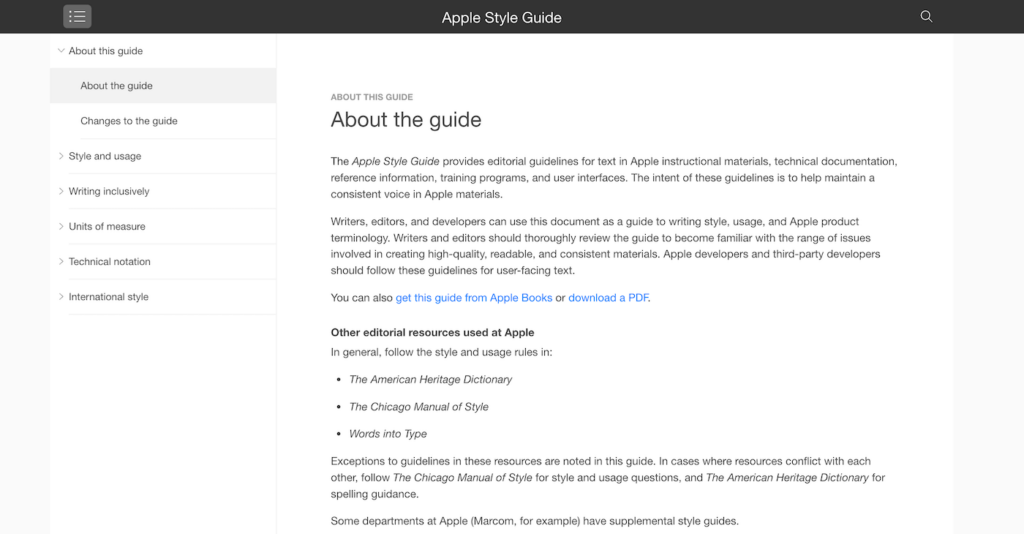
Over some 220+ pages, Apple corporate style guide first provides vocabulary-style information on correct term usage.
Then has an extensive section on inclusive language usage, followed by technical writing guidelines and tips on adapting content to international audiences.
Microsoft Corporate Style Guide
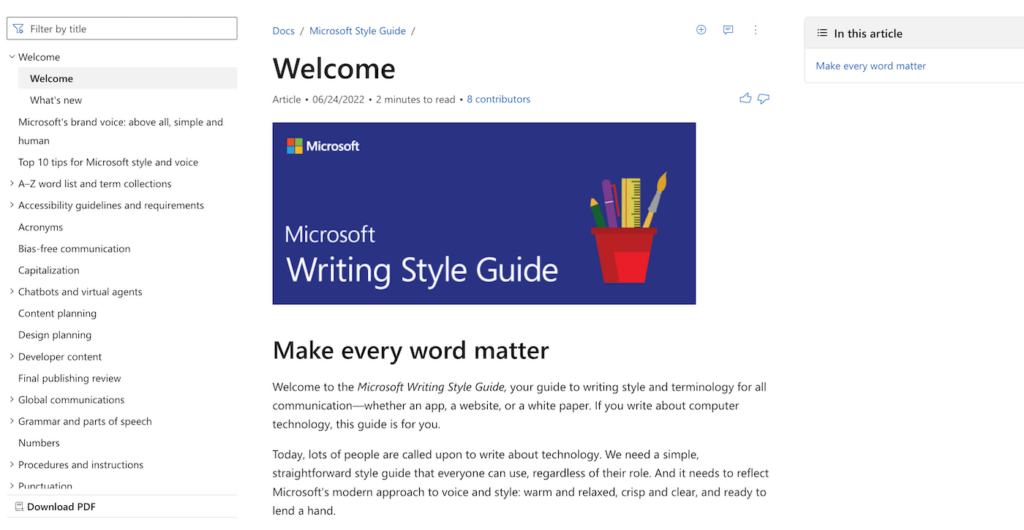
Microsoft has an in-depth online writing style guide with pointers for maintaining the preferred style of communication across all assets.
Apart from covering basics like brand terms and grammar usage, their house guide includes technical documentation tips, chatbot content creation, internal procedures, and how-to content development, plus tips for writing SEO-friendly content.
Search Engine Journal Style Guide
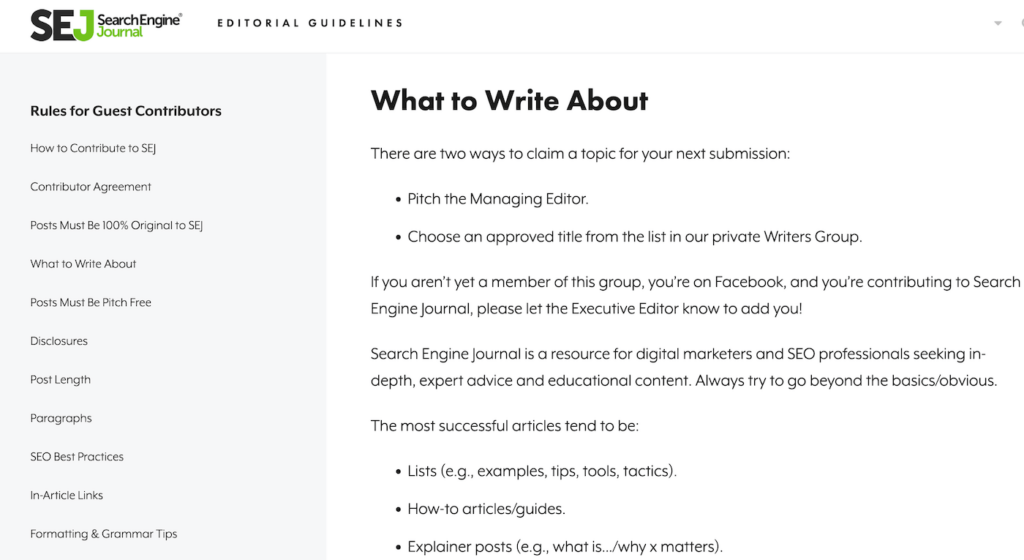
Search Engine Journal meshes its style guide with contributing author guidelines.
Since it’s designed for external writers, the guide focuses more on story ideas, general formatting rules, and SEO best practices. To reduce editorial work, they provide detailed information upfront. That’s a smart thing to do.
Mailchimp Style Guide
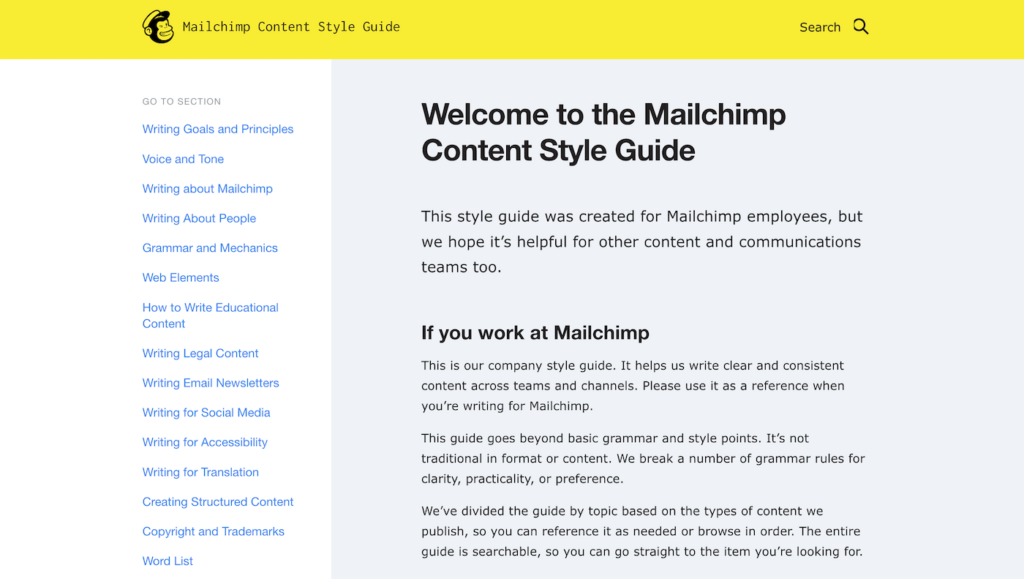
Mailchimp breaks down the mechanics of corporate writing for different content formats — web copy, educational materials, legal contracts, newsletters, social media, and case studies.
Their guide leaves no room for ambiguities and directs the reader towards extra resources on branding, accessibility, and copyrights.
How to Create Your Own Style Guide for Content
If you want to create compelling content systematically, a writing style is a must.
It addresses common questions before they arise among new content marketing team members or hired freelance writers.
Complete these six steps to create a preferred style guide for your brand.
1. Document Your Brand Persona
Unlike academic style guides, an editorial style guide focuses on communicating your company’s ethos using specific voice, values, catchphrases, and other stylistic elements.
As the preface of The New York Times Manual of Style says:
“Style, with a capital S, achieves what a rule book never can: it lights the page, draws readers, earns their delight, makes them gasp or weep, and sometimes captures a place in memory.”
Preface your style guide with an introductory brand personal section to communicate brand knowledge.
Brand Tone and Voice
A brand voice is how you express your ideas in the world.
Similar to a physical voice, brands cultivate unique:
- Tonality – fun, snarky, savvy, serious, chirpy
- Language – common word choices, catchphrases, buzzwords
- Character – “helpful neighbor,” “a BFF,” “a senior mentor,” etc.
A memorable and consistent voice differentiates your company from others on the market and helps cultivate emotional bonds with consumers. That’s hugely important because 62% of consumers feel they have a relationship with a brand. Their sentiment and brand perception drives purchase decisions and cultivates loyalty.
To create a tone of voice for your company, try these tips:
- Document your central company values first.
- Then make a list of adjectives that could describe a person, showcasing these values.
- Translate these descriptions into writing prompts and guidelines.
For example, Atlassian’s brand personality has three distinctive pillars:
- Boldness
- Optimism
- Practicality with a wink
To help writers infuse these characteristics into their writing, the company’s style guide provides several great prompts:
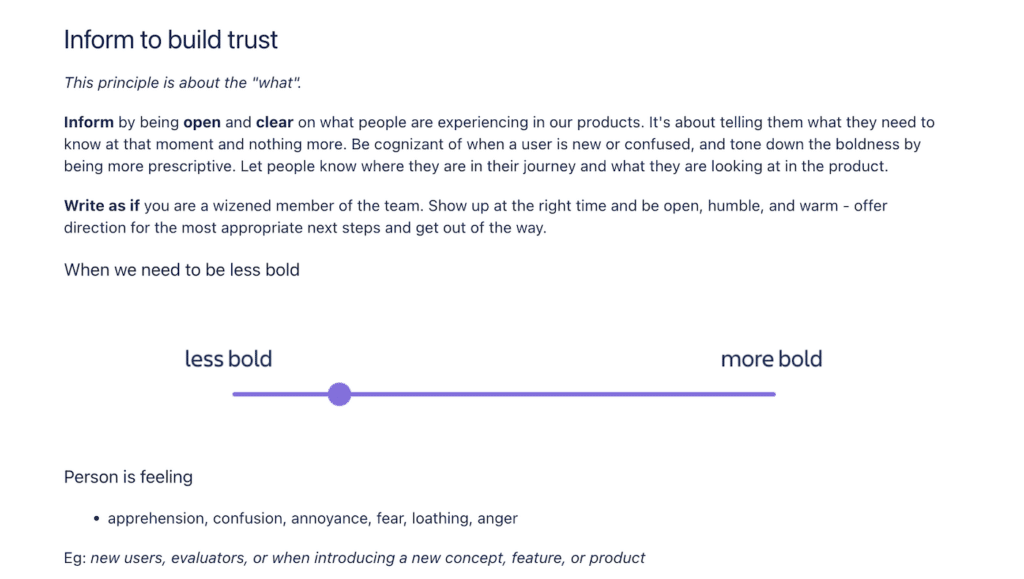
Tone of voice development takes time and experimentation. So don’t rush it!
Brand Values
Values also shape our personalities.
To nail down your tone of voice, consider what your company stands for in the first place.
- What qualities do you value at the workplace?
- What beliefs do you want to share with the public?
- What turf are you willing to defend with all your might?
Think about how you wish to be perceived by your target audience. Put these down as key elements of your brand personality.
Intuit – a popular accounting app – describes its brand personality through five value-driven adjectives:
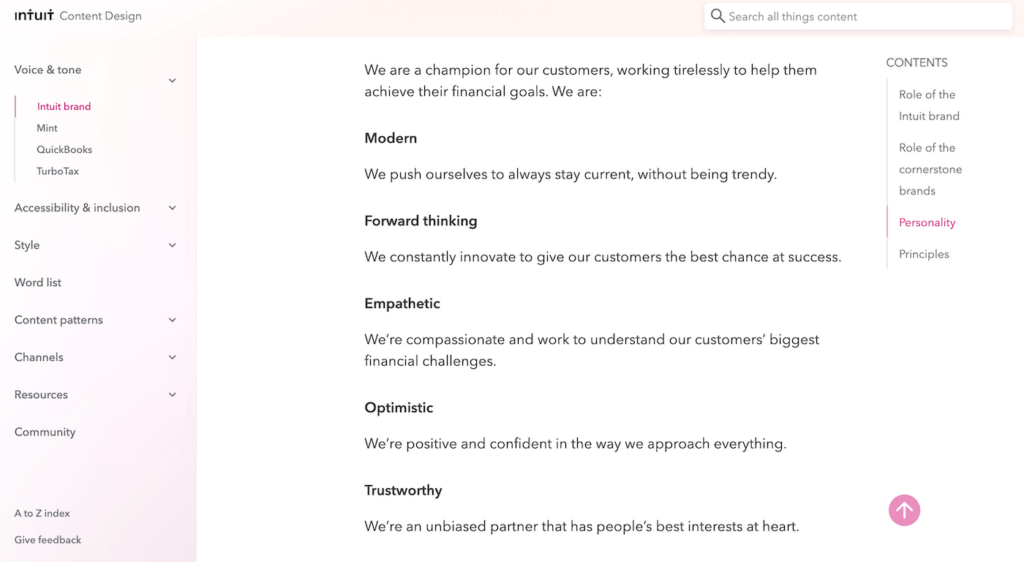
Brand Associations
The easiest way to document your brand persona is by asking your target audience for prompts.
Survey your brand fans on their associations:
- What words do they use to describe you?
- Are you helpful? Aloof? Friendly? Inspirational?
Use the collected voice of customer data to shape your brand personality and tone.
2. Content Formatting Requirements
Include a “manual” section next and document all your preferences on content formatting. Doing so once is exhaustive, but it will save your editors heaps of time in the long run.
A comprehensive content formatting section includes:
- A primer on grammar and punctuation rules for the type of English you use (American English, British English, Australian English, etc.). For example, Oxford comma, m-dash/n-dash, or quotation marks usage.
- Stylistic content formatting requirements such as typeface, font size, header and subheader capitalization, internal/external link requirements, etc.
- Guidelines for citing statistics, documenting sources, providing citations, and making claims paired with tips for fact-checking.
- Tips for content localization include preferred date format, units of measure, currencies, and so on.
- Extra requirements for visual elements such as image credits, brand visual asset usage, image sizes, etc.
To avoid making this section boring, illustrate some of your rules with examples or short stories.
Monzo style guide sprinkles in highlighted sections with “curiosities and good-to-knows” about the English language.
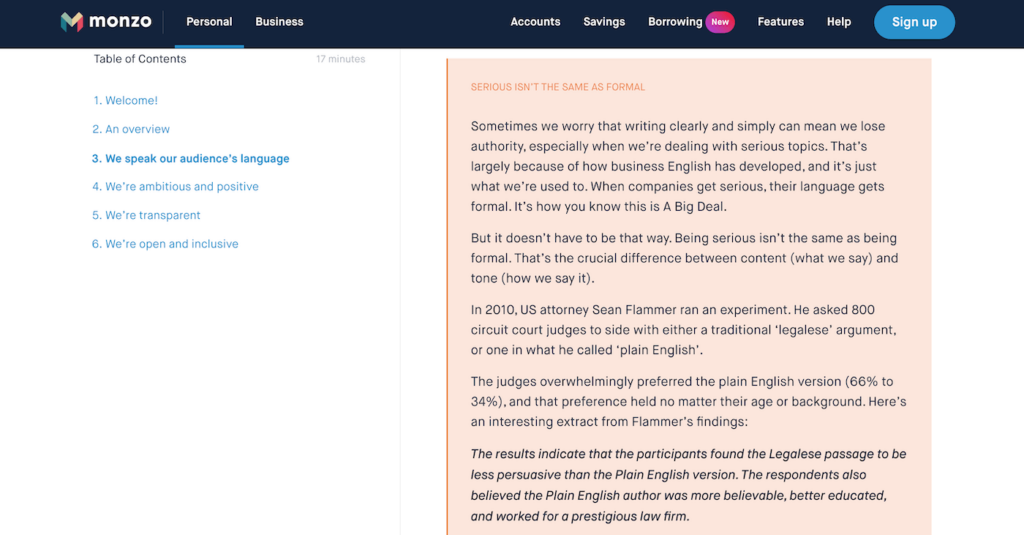
3. Add a Glossary Section
To minimize the volume of redundant edits and inconsistencies, start building a glossary section.
Include:
- List of brand terms, catchphrases, common abbreviations, and acronyms used uniformly in your communication.
- Preferred word choices. For example, always using simpler alternatives (“use” over “usage”) and preferred spelling variations for ambiguous words (ecommerce over eCommerce).
You can also add a note on your preferred dictionary or academic publication manual for writers to refer to when in doubt.
That’s what BuzzFeed does to minimize inconsistencies in submitted stories.

4. Include an Overview of Your Editorial Process
To maintain a good publishing cadence, each writer you work with must understand your editorial process.
It’s especially true if you ever decide to outsource content creation or invite guest authors to your blog.
Even if you don’t, a short overview of your editorial process helps new in-house writers get up to speed and create content with consistent quality.
In your style guide, provide helpful details about your content development process:
- Showcase the main steps in your content creation lifecycle.
- Explain how to pitch ideas or how topics get assigned to writers.
- Mention the must-does before forwarding a finished piece to the editor/content manager.
- Detail average review time and publishing frequency.
- Provide extra pointers for content staging in the website CMS.
Larger organizations also include links to their visual style guide — a more comprehensive document also covering the brand look, aesthetics, and UX elements.
Shopify, for example, combines written and visual style guides into a design system called Polaris.
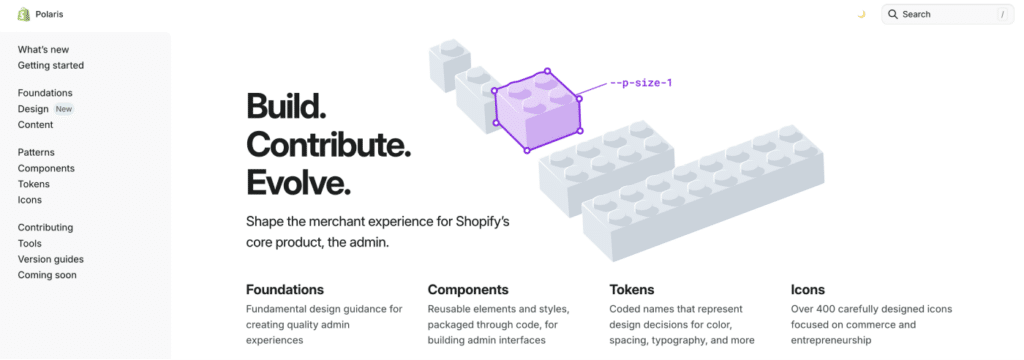
Styled as a separate portal, Polaris hosts information for designers, developers, and content creators working together to create a unique brand experience.
5. Document Accessibility and Inclusivity Principles
Your target audiences are wonderfully diverse.
Ensure your writing and content presentation don’t exclude or impede people with special needs.
To be diplomatic and welcoming, document web accessibility and inclusive language principles in your style guide.
Web Accessibility
Web accessibility refers to principles applied to websites and digital tools so that people with audio, visual, speech, or cognitive impairments can interact with them.
The World Wide Web Consortium (W3C) organization developed and maintains these guidelines and encourages brands to follow them.
Web Content Accessibility Guidelines (WCAG) are easy to implement:
- Use alternative texts for visual content
- Add captions or subtitles for multimedia content
- Include options for users to see and hear written content
- Create simple, intuitive navigation paths for browsing
- Use readable fonts and avoid flashy design elements
- Ensure content appears and operates in predictable ways
QuickBooks includes helpful links to web accessibility tools and cheat sheets in its visual style guide:
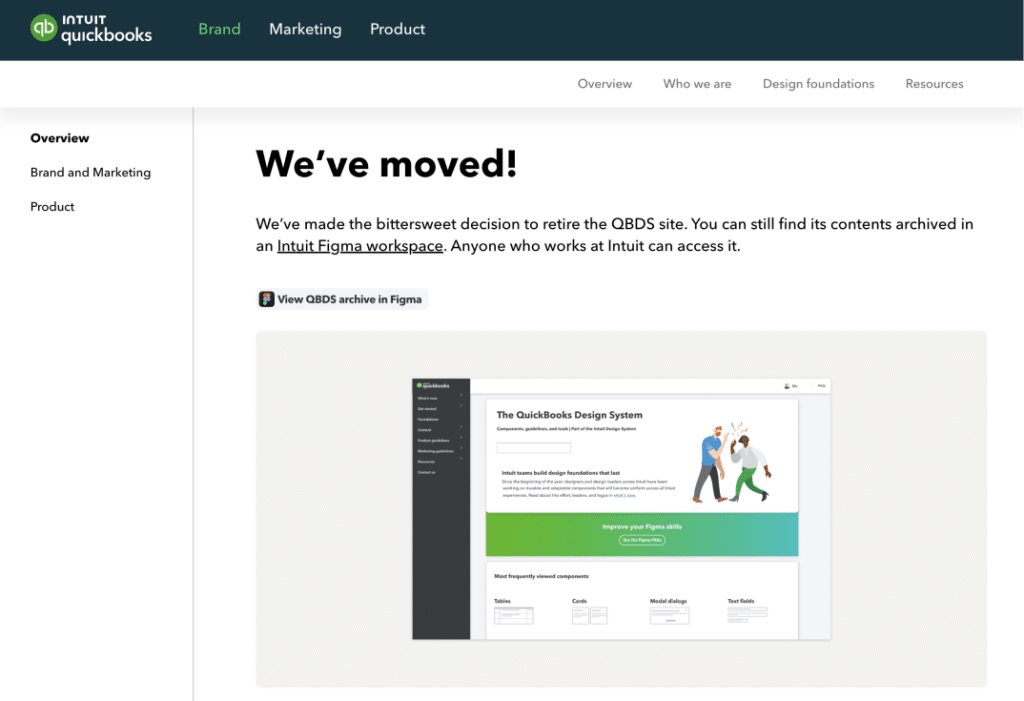
Inclusive Language
Inclusivity in writing means deliberately avoiding terms, phrases, or other indicators, which might be interpreted as biased, denigrating, or prejudice towards any group of people.
An inclusive language doesn’t cultivate any types of -isms.
To practice this, add quick notes on:
- Prioritizing gender-neutral pronouns and using person-preferred pronouns.
- Avoiding the use of the masculine as a default way to describe people.
- Using the correct LGBTQ+ terms when referring to members of this group.
A writing style guide from Buffer has a top-notch section on inclusive language with helpful tips and pointers:
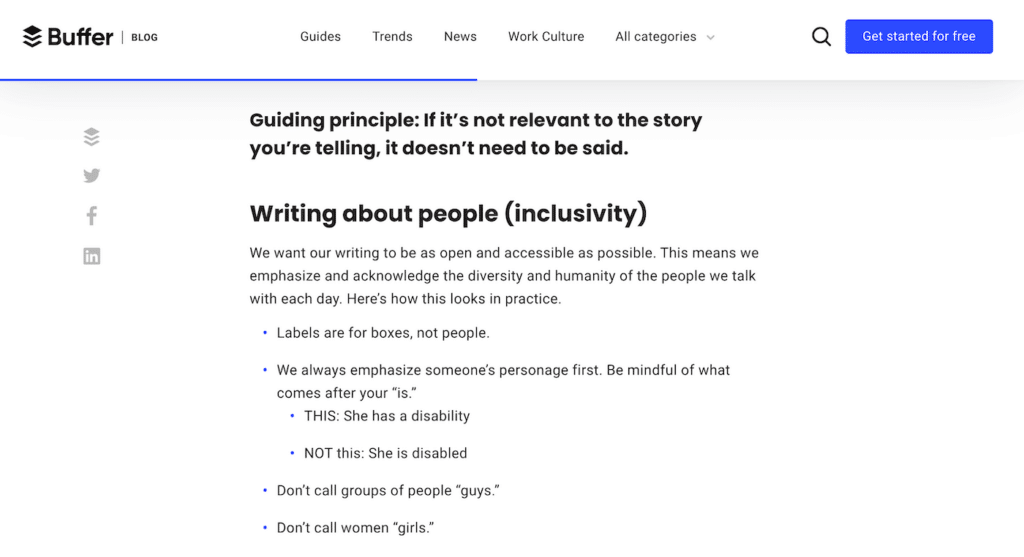
6. Share and Update Your Style Guide Regularly
Your house style guide is an ever-evolving document. You don’t make it in one sitting and then hide somewhere deep on a corporate virtual shelf.
Store your style guide at short reach as:
- Separate website page, section, or sub-domain.
- Shared document on Google Drive.
- Hosted page on Notion or Slite.
- Internal document in your content management platform.
Update it regularly based on new feedback from editors, internal questions from writers, inquiries from external contributors, and broader changes in your branding.
Diligence is key to consistency. You can’t cultivate uniformity in style among your writers unless you set the example yourself.
FAQs about editorial style guides
What is the most commonly used style guide?
The Associated Press (AP) writing style guide is the most widely used manual since most news and media publishers rely on it.
First published in 1953, the AP style guide has been reprinted 56 times, roughly every new year.
The MLA style guide by the Modern Language Association is the second most-used guide, as it’s the go-to for most academic institutions and publishers.
Who should create a content style guide?
Every brand serious about corporate communication and content marketing must produce a writing style guide.
As long as you have more than one professional writer working on corporate communication materials, the effort will be well worth it!
Content style guides are a must for any company working with freelance writers or content marketing agencies.
Why have a content style guide?
A style manual helps achieve consistency in word usage, formatting, tone of voice, and other branding elements.
Without it, you risk confusing consumers with sporadic naming of different products, features, or user interface elements.
On the marketing side, you risk sounding incoherent and looking unprofessional if your web content lacks consistency in formatting and style.
What should a content style guide include?
At a minimum, a solid editorial style guide includes brand tone of voice and personality overview, a short glossary of common terms, formatting requirements, grammar and punctuation prompts, and tips for writing inclusively.
